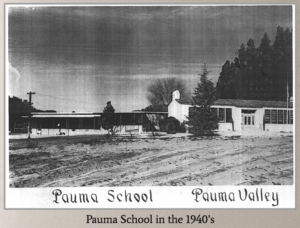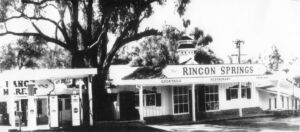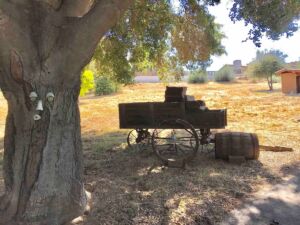Pauma Valley and Astin History – Past and Present
The land in Pauma Valley has a long and interesting history beginning when California was still part of Mexico…
“Pauma: an Indian word meaning “I bring water” or “a place where there is water”
This reference is to the San Luis Rey River which flows through this valley
Early History:
1795
The area known today as Pauma Valley has been home to Indians for centuries. Early Spanish maps identify the Pauma region as an Indian rancheria. In 1795, an exploration party from the San Diego Mission, led by Fra. Juan Mariner, was the first group of white men to visit the area.
1816
San Antonio de Pala was a sub-mission of Mission San Luis Rey de Francia. It was established in 1816 by Padre Antonio Peyri and is the only surviving Asistencia in the mission system and the only mission-related structure still ministering to an Indian population. The Asistencia was named in honor of Saint Anthony of Padua, nicknamed the “Wonderworker of the world.” Pala continues to be an active Church. Wedding Ceremonies can still be held here:
1844
Rancho Era: In 1844, a Mexican Land Grant of three square leagues (13,310 acres) was given by Governor Manuel Micheltorena to Jose Antonio Serrano. He called it Rancho Pauma. Serrano, said to be a splendid horseman who regularly took part in bullfights, built an adobe home and stocked the ranch with cattle and horses. Adobe walls of the original house were 24 inches thick.
1845
Rancho Cuca: Adjoining Rancho Pauma to the east was a one-half square league parcel (2,174 acres) given by Mexican Governor Pio Pico in 1845 to Maria Juana de los Angeles, an Indian. Among the more prominent owners of the Cuca Ranch in later years was the Mendenhall family which called it Potrero Ranch. Today, the property is surrounded by the La Jolla Band of Luiseno Indians.
1846
Pauma Massacre: Rancho Pauma’s place in history is marked by an event in 1846 in which more than 100 persons were killed. The attack, which began at Serrano’s adobe home, was to become known as the Pauma Massacre. The killings occurred during the transition from Mexican to U.S. jurisdiction of California.
1884
P.S. Sparkman and the Rincon Store: This was the first general store serving Pauma Valley and was operated by Philip Stedman Sparkman from 1884 until his murder in 1907. The store was at the southwest corner of Pala and Rincon roads (present-day Valley Center Road and State Route 76). Sparkman, however, was best known as an ethnologist who studied Luiseno culture and published a dictionary of the Luiseno language. His definitive work, “The Culture of the Luiseno Indians was published after his death. Sparkman’s original manuscript is in the archive of the Valley Center Historical Society.

1889
Historic Stage Stop:A contract operator for the famous Butterfield Overland Stage Line made a regular stop at the Rincon Store in the late 1800’s. A watercolor of the stage and the store was painted by famed Western artist Marjorie Reed. It is on exhibit at the Valley Center History Museum. The store was acquired in 1920 by William C. Clark who opened Pauma’s first gasoline station and installed the first public telephone. After Clark’s death, the property was sold to Thomas Colby who operated Rincon Springs cafe until 1962. The restaurant, whose roots were said to date to 1889, was destroyed by fire in 1976. An adjoining adobe, originally owned by Sparkman, fell into disrepair and was abandoned. The property at the time was owned by John Hankey.
1881
Sickler Grist Mill: In 1881, the Sickler brothers operated the region’s only Grist Mill on this site. Farmers would bring wagons filled with corn, wheat and barley to be ground. The grist mill’s original foundation still stands. The preserve is at 14209 Pala Road.
1892
Pauma Reservation: In 1892, much of the original Serrano ranch site was designated as part of the Pauma-Yuima Reservation, home to the Pauma-Yuima Band of Mission Indians, the historical name for the tribe generally known as the Pauma Band of Luiseno Indians. The architecturally distinctive Pauma Indian Chapel was built about 1878. The Reservation today covers 6,000 acres.
1917
School Houses: A one-room redwood structure known as ‘the little red schoolhouse” served Pauma Valley from 1917 to 1937. It replaced an earlier school that was swept away in the floods of 1916. Some 30 children generally rode horses to the K-8 school located near 14715 Pala Road. It closed when the new Pauma School opened on Cole Grade Road. Efforts to save and restore the former little red schoolhouse in the mid 1980’s failed, and neglect and winds eventually toppled the building.

1920
Kellogg Store:The general store and cafe commonly called Pauma Store was started about 1920 by the Kellogg family (Daniel Preston and son Ralph) who also purchased and lived in the original Serrano adobe. Their property covered 100 acres planted in walnuts. The store is at 15035 Pala Road.
Ralph Kellogg married Eugenia Weimer in 1930. After his death in 1945, she married Milton L. Cheney (divorced 1960) and later married Edward Miller. As Genie Miller, she operated the Pauma Store for more than half a century. At the end of Prohibition in 1933, the store was issued one of three original liquor licenses in San Diego County.
1920
Lazy H: Originally a working ranch started in 1920, the Lazy H became a private resort in 1950 known as the Lazy H Sky Ranch and attracted local celebrities. It was operated by Thomas Colby. Lazy H operates today as a motel and restaurant at 16787 Pala Road.

1954
Wilderness Gardens: Although this 737-acre property has a Pala address, it has been more closely associated with Pauma Valley. Horticulturist Manchester Boddy purchased the parcel in 1954 and developed a major botanical garden. In 1973, the garden was turned over to the County of San Diego to be operated as an open-space preserve. The grist mill’s original foundation still stands here too. The preserve is at 14209 Pala Road.
1971
Historic Designation: The Serrano Adobe was declared a California Historic Landmark in 1971 and a road marker was installed near 15067 Pala Road, approximately 700 feet off the west side of the roadway. It was the first San Diego County landmark designated by the California Historical Landmarks Commission. For a time, tours were offered. In 1998, new owners expanded the adobe by adding 1,700 square feet in two stories. The property, at 52 acres, was sold in 2003 and is owned by TY Nursery.
Local Native Americans in the Valley Center Area
Archaeological sites around the area prove that it has been a favored place to live for thousands of years. Evidence of these habitation sites can be found throughout the area. The year-round availability of food, water and resources provided a peaceful and stable existence for those early inhabitants.
Five Indian Reservations are within the Valley Center area: Pala, Pauma, Rincon, La Jolla, and San Pasqual. Of these, three separate groups are represented: Luiseno, Diegueno, and Cupeno. Named for the Spanish missions, the Luiseno lived near the Mission San Luis Rey and the Diegueno for the Mission San Diego de Alcala. San Pasqual is the northernmost Diegueno, or Kumeyaay, reservation. The Cupeno lived near Warner’s Ranch in their village of Kupa prior to being moved to the Pala Reservation in 1903.
1900’s
PAUMA VALLEY TO THE PRESENT:
Framed by the Cleveland National Forest, Pauma Valley Country Club rests in a valley of the San Luis Rey River that is rich in history and today retains the best of Old California. The first residents along the river were small tribes of Indians, and one tribe, the Paumas, took their name from an Indian word which means” spring water.” For thousands of years the tribe enjoyed Nature’s bounty, with the river and valley providing all that they needed.
1950’s:
PAUMA VALLEY COUNTRY CLUB begins!
As new settlers arrived in the early-to-mid -1900’s, they transformed the valley into the rich agricultural area that it is today. Over time, some of those early ranches became the special parcel of land that would be used to create the Pauma Valley Country Club. These early residents and visitors ranged from citrus farmers and cattle barons to Hollywood celebrities, including John Wayne. For many decades the John Wayne Ranch House stood next to what it is now, the 14th tee. Pauma Valley’s potential as the site for a superb golfing facility and residential community was first realized in the early 1950’s.
1957
Pauma Valley Country Club: A corporation was formed, and over the next two years the group purchased thousands of acres in the valley. Robert Trent Jones was brought in as a designer of the proposed 18-hole championship golf course.
The John Wayne Ranch House served as the Club’s temporary Clubhouse. The golf course was opened for play on November 1, 1960 and within a few years special televised golf matches were held at the course, featuring such well-known golfers as Arnold Palmer and Gary Player.
The Pauma Valley Country Club continues to operate as a private golf and country club, one of America’s most exclusive hideaways that is dedicated to preserving the charm of Old California and the great game of golf.
Pauma Valley Country Club fits comfortably into the surrounding community and is known as a good and supportive neighbor. Our members support the local elementary school through the Pauma Schools Foundation. The Club and the residential area around it are protected by manned gates and patrol services provided by Pauma Valley Community Services District. Water, an increasing scarce resource in Southern California, is supplied by the local water company which owns superior water rights and 14 wells with complete delivery infrastructure.
THE PRESENT:
The EH ASTIN FARM,LLC acquires The DeLOREAN PROPERTY
and on June 1st, 2018 THE ASTIN RETREAT was founded in Puma Valley, CA
LINK’s to more history:
“Pauma Valley: San Diego’s Shangi-La”
Article on Pauma Valley: John Wayne
Article on Pauma Valley in San Diego Magazine: San Diego’s Secret Spots:
Article by the Union Tribune on the Famous Stars who lived in the area:
When the Stars Shown in the Valley:
Article by LA Times: The Valley’s Eclectic Devotees: Farmers, Indians, Even a Snazzy Club Call It Home
LINK’s to The DeLOREAN INFAMOUS HISTORY:
1960’s House with a history: Inside John DeLorean’s mansion: CBS 8 news featured video on the Deloreon Mansion:
1989: LA TIMES ARTICLE:
Appeals Court Says Property Fair Payment for Attorney: Transfer of DeLorean’s Pauma Valley Estate Upheld
LA TIMES ARTICLE:
For sale: Former home of DeLorean makerLA.CURBED reports: Carmaker John
DeLorean’s Country Club House Too Uncool to Be Modified For Time Travel
REALTOR.COM Article: John DeLorean’s House Does Not Have Gull Wing Doors
DELOREON HISTORY and his MANSION THAT SAVED HIM:
Long before Elon Musk, a visionary automaker showed how ugly the American Dream could be: John DeLorean, The Rise and Fall of Big Money
Pauma Valley Custom Home for Sale, Tour by Kim Senecal – 32220 Cuesta De Camellia (CA 92061):
John Z. DeLorean’s $2.18 Million House Sadly Does Not Have Gullwing Doors
DeLorean Wants House To Go To His Attorney:
PROPERTY FACTS FROM REAL LIVING REAL ESTATE: Property Facts
The EH ASTIN FARM,LLC acquires The DeLOREAN PROPERTY and on June 1st, 2018 THE ASTIN RETREAT was founded in Puma Valley, CA:

THE ASTIN PAST:
1877 EH ASTIN FARM
The EH Astin Farm, founded in Texas in 1877, was relocated to Pauma Valley, CA and The Astin Retreat was created.
1877 to Today:
The Astin Farm & Founding Family Roots:
ASTIN FARM FOUNDER:
1833
James Hugh Astin was a true pioneer. Born in Marion County, Alabama November 1833 the son of James M. and Cynthia Young Astin. James first came to Texas. He then went to California to be a minor. Later James then returned to Texas to enter the Confederate Army. He served in the Company I, Fourth Texas Cavalry, Hood’s Brigade until severely wounded at the battle of Chickamanga.
1864
James returned to Texas and in 1864 married his first wife Celia Allsbrook in Navarro County. A year later he moved to Bryan, Texas. He tried several occupations.
1867
James moved his wife and his baby boy on to a rented piece of land in the Brazos bottom. His sole possessions were a wagon, team and ten dollars in money.
1877
James made his first land purchase 10 years later in 1877 and founded the Astin Farm.
1878
James married his second wife Onah Ward of Bryan.
When James Hugh Astin died October 7, 1897 he owned over 7000 acres, 6000 under cultivation and was considered one of the wealthiest planters in the state of Texas.
1897
Onah Ward Astin was born February 28th, 1856 in Phillips County, Arkansas. She was the daughter of William A. and Caroline Ward. Onah married James Hugh Astin and lived on their plantation home on the Brazos river until James died October 7th, 1897. She was a great mother raising their six sons and one daughter.
E.H. Astin was the eldest son of James Hugh and Onah Ward Astin. Born May 18, 1889, he graduated from A & M College. Ervin played on the A & M football team. He served as President of the A & M College Board of Directors from 1912 to 1919. Later he served as President of the Texas Penitentiary Board and was President and Chairman of the Board of City National Bank. E.H. Astin was the eldest son of James Hugh and Onah Ward Astin. Born May 18, 1889.
May 18, 1889
Ervin married Myrtie Conway and they had Onah Mae Astin Barwise and raised Myrtie’s sister’s daughter Myrtle Dillard Rawlins as their own.
1956
Ervin died May 1956 leaving his farm to his daughter Onah Mae Astin Barwise, her two daughters Onah and Betty Ann Barwise and three granddaughters Onah Penn Wiley, Margaret Penn Farrell and Anseth Barwise Page Richards.
June 1, 2018
Today Anseth Barwise Page Richards along with her husband Keith Richards and their four children Taylor Arthur Richards, Sienna Astin Feerrar, Avalon Page Richards and Waverly Ann Richards continue to maintain The Astin Farm, now also a ranch and retreat which relocated from Texas to Pauma Valley, California on June 1, 2018.
June 1st, 2018
The Astin Farm makes a move…
Good Bye Texas, California here we come:
THE ASTIN, Farm, Ranch and Retreat is available now on Airbnb:
A link to the original Astin Farm in the Brazos River bottom in Texas Astin Farm Roots:
